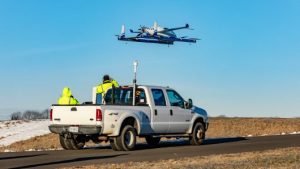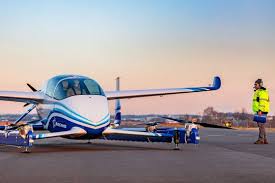Many startup companies have cropped up, trying to launch their own flying taxi projects, and now that the concept has been proven, the giant aerospace makers are jumping into the fold. One of them, multinational giant Boeing, has just completed the first test flight for its very own vertical takeoff and landing (VTOL) electric air taxi.
The test “flight” took place very recently at an airport just outside of Washington D.C. No one was aboard for the test, which lasted less than a minute and involved the air taxi hovering at an unspecified height over the runway.
 Boeing’s long term plans are to be able to transport passengers a maximum of 50 miles at a time. Clearly, there’s much work to be done before we reach that point and can catch a Boeing flying taxi to the home or office. Having said that, this demonstration is certainly a leap forward.
Boeing’s long term plans are to be able to transport passengers a maximum of 50 miles at a time. Clearly, there’s much work to be done before we reach that point and can catch a Boeing flying taxi to the home or office. Having said that, this demonstration is certainly a leap forward.
“In one year, we have progressed from a conceptual design to a flying prototype,” said Greg Hyslop, Boeing’s chief technology officer, in a statement. “Boeing’s expertise and innovation have been critical in developing aviation as the world’s safest and most efficient form of transportation, and we will continue to lead with a safe, innovative, and responsible approach to new mobility solutions.”
 Boeing has yet to name their flying taxi, and unlike Boeing planes, there will be no pilot for the flying taxi. Instead, flights will be piloted autonomously, similar to a number of other similar projects. Boeing hasn’t revealed how many passengers the 30-foot-long craft will be able to transport at one time, but it’s likely to be a maximum of one or two. Boeing is also reportedly working on a larger vehicle capable of transporting a maximum cargo of 500 pounds.
Boeing has yet to name their flying taxi, and unlike Boeing planes, there will be no pilot for the flying taxi. Instead, flights will be piloted autonomously, similar to a number of other similar projects. Boeing hasn’t revealed how many passengers the 30-foot-long craft will be able to transport at one time, but it’s likely to be a maximum of one or two. Boeing is also reportedly working on a larger vehicle capable of transporting a maximum cargo of 500 pounds.
Other large companies are working on similar projects like Boeing’s, including Google’s Kitty Hawk, Uber, Rolls-Royce and Aston Martin. Boeing, however, may be slightly late to the party, but its experienced R&D division and deep pockets could make up for their tardiness.





